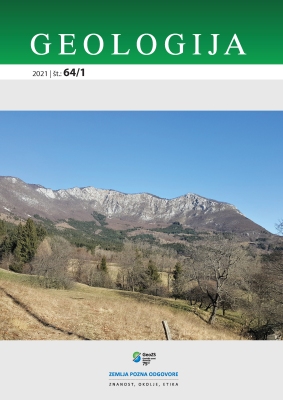Late Carboniferous biota from the Ljubija iron mine area, Bosnia and Herzegovina
DOI:
https://doi.org/10.5474/geologija.2021.004Abstract
The Olistostrome member of the Sana-Una Paleozoic complex of the Ljubija ore mine in Bosnia and Herzegovina contains limestone fragments of pebble to block size that have been examined paleontologically. The recovered conodont fauna of the first sample is characterized by the species Declinognathodus lateralis, Idiognathoides sulcatus sulcatus and Idiognathodus sp. confirming its mid-Bashkirian age. This report is the first on the occurrence of these taxa in the area. The second sample with chaetetid demosponges yields an abundant diversified microbiota consisting of cyanobacteria, algae and foraminifera. Chlorophyts are marked by the common siphonoclad occurrence of Donezella lutugini and D. lunaensis, whereas rhodophyts include rare representatives of Stacheia, Stacheoides, Pseudoungdarella and Masloviporidium. The presence of Asphaltinella horowitzi and Aphralysia carbonaria of unclear taxonomic position is also documented. Pseudostaffellids, eostaffellids and other foraminifera, mostly endothyrids are present. The examined associations of fossils point to the Bashkirian age of the primary rock that originated in a very shallow habitat most probably linked to a high-energy reef environment.Downloads
How to Cite
Milošević, A., Alekseev, A. S., Zaytseva, E., Novak, M., Kolar-Jurkovšek, T., & Jurkovšek, B. (2021). Late Carboniferous biota from the Ljubija iron mine area, Bosnia and Herzegovina. Geologija, 64(1), 65–80. https://doi.org/10.5474/geologija.2021.004
Issue
Section
Articles

